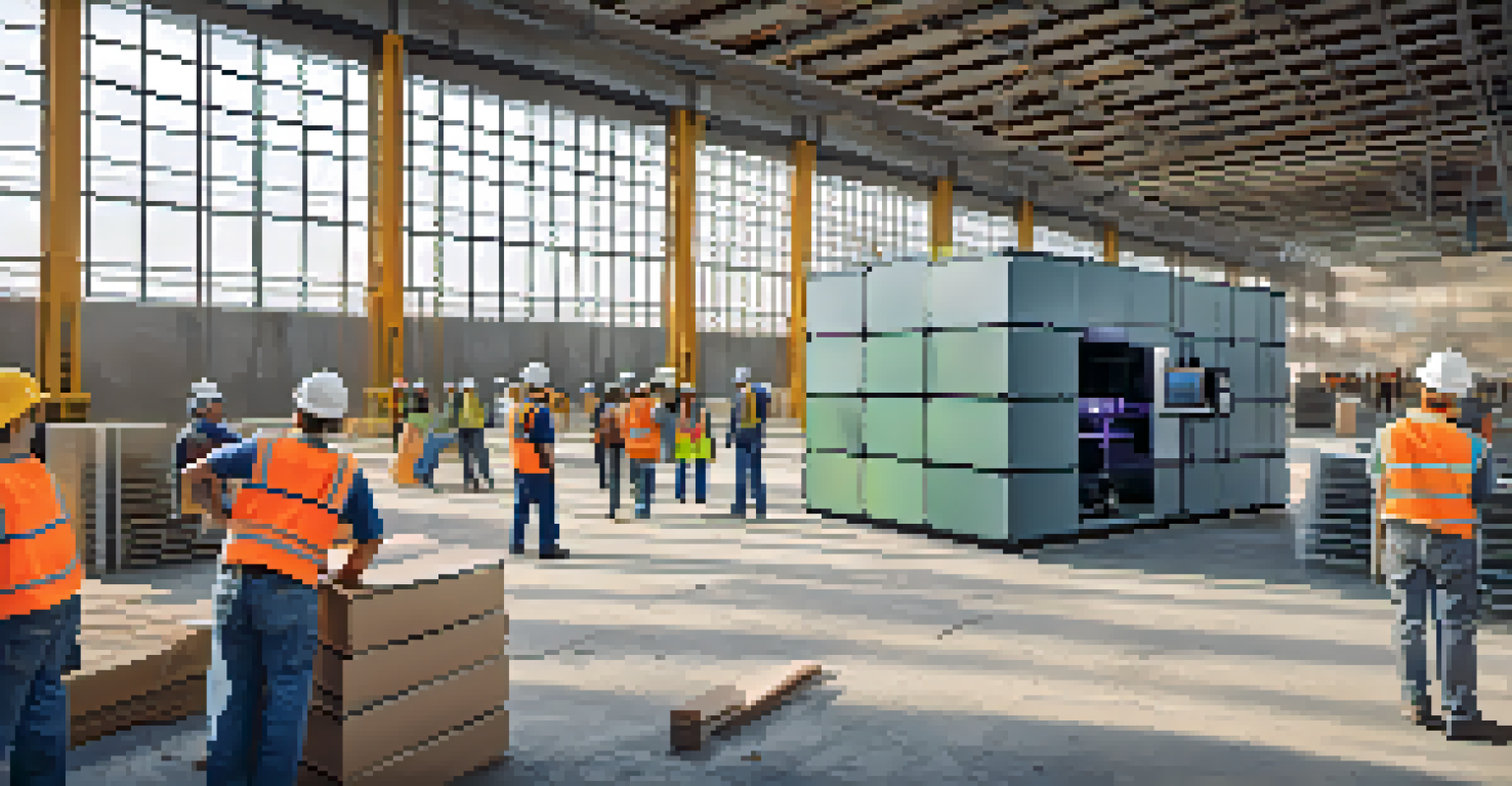The Future of 3D Printing in Sustainable Building Practices

What is 3D Printing and Its Role in Construction?
3D printing, also known as additive manufacturing, involves creating objects layer by layer from digital models. In construction, this technology allows for the rapid production of building components, significantly reducing waste. Imagine printing a house like you would print a document; this innovative process can streamline traditional construction methods.
3D printing allows us to rethink how we build, enabling a future where construction is not only faster but also more sustainable.
The versatility of 3D printing enables the use of various materials, including concrete, plastics, and even recycled goods. This opens the door to more sustainable options, allowing builders to incorporate eco-friendly materials easily. As we adapt to climate change and resource scarcity, this technology presents an exciting opportunity to rethink how we build.
Moreover, 3D printing can facilitate on-site construction, minimizing transportation emissions and reducing the carbon footprint associated with traditional building methods. By bringing the manufacturing process closer to the final location, we can foster a more efficient and environmentally-friendly approach to construction.
Benefits of 3D Printing for Sustainable Practices
One of the most compelling benefits of 3D printing is its ability to minimize construction waste. Traditional construction methods often result in excess materials, but with 3D printing, materials are used precisely as needed, reducing waste significantly. It's a bit like cooking with a recipe; you only use the ingredients specified, which leads to less leftover food.

Additionally, 3D printing can lower energy consumption throughout the building process. By optimizing designs and eliminating unnecessary materials, the energy required for production and transport can be drastically reduced. This efficiency not only benefits the environment but also translates to cost savings for builders and consumers alike.
3D Printing Reduces Construction Waste
By using materials precisely as needed, 3D printing significantly minimizes waste compared to traditional construction methods.
Furthermore, 3D printing can enhance the design flexibility of buildings, allowing for innovative shapes and structures that were previously challenging to achieve. This creativity can lead to more energy-efficient designs that maximize natural light and airflow, improving the overall sustainability of the building.
Case Studies: Successful 3D Printed Buildings
There are several inspiring examples of successful 3D printed buildings that showcase the potential of this technology. One notable project is the 'Yhnova' house in France, which was printed in just 54 hours and is made from a unique insulating mixture. This project not only demonstrated the speed of construction but also highlighted the potential for affordable housing solutions.
The future is not about building more; it's about building better, with materials and methods that respect our planet.
Another remarkable example is ICON’s 3D-printed homes in Austin, Texas. These homes are designed to be both affordable and sustainable, utilizing a proprietary concrete mix that is eco-friendly. By focusing on cost-effective solutions, these projects aim to address the housing crisis while promoting sustainable practices in construction.
These case studies illustrate that 3D printing is not just a concept for the future; it's a reality that is already making a significant impact. As more builders adopt this technology, we can expect to see even more innovative projects that prioritize sustainability.
Challenges Facing 3D Printing in Construction
Despite its potential, 3D printing in construction faces several challenges that must be addressed. One major hurdle is the regulatory landscape, as building codes and standards are often not yet adapted for 3D printed structures. This can create uncertainty for builders and investors, slowing the adoption of this promising technology.
Another challenge is the initial investment required for 3D printing technology. While costs are decreasing, the upfront expenses for purchasing printers and materials can be significant. Many builders may be hesitant to make the leap without clear evidence of long-term benefits and return on investment.
Innovative Materials for Sustainability
The development of sustainable materials, such as bio-based plastics and recycled composites, enhances the eco-friendliness of 3D printing in construction.
Finally, there is a need for skilled labor that understands both construction and 3D printing technology. As the industry evolves, training programs will be essential to equip workers with the skills necessary to operate and maintain 3D printing systems effectively.
The Role of Materials in Sustainable 3D Printing
The choice of materials plays a crucial role in the sustainability of 3D printing in construction. Traditional materials, like concrete, can be resource-intensive and contribute to carbon emissions. However, advancements in material science are leading to the development of more sustainable options, such as bio-based plastics and recycled composites.
Using local materials can also enhance sustainability by reducing transportation impacts. Imagine a building that incorporates locally sourced earth or waste materials; not only does it lower emissions, but it also supports the local economy. This locality can make a significant difference in the overall sustainability of a project.
Moreover, researchers are exploring innovative materials like mycelium, which is derived from mushrooms, and can be used as a biodegradable alternative to traditional building materials. By embracing these new materials, the construction industry can pave the way for a more sustainable future.
Integrating Renewable Energy with 3D Printed Buildings
Integrating renewable energy solutions into 3D printed buildings is another exciting area of exploration. By designing structures that accommodate solar panels, wind turbines, or even geothermal systems, we can create homes that generate their own energy. This shift towards energy self-sufficiency aligns perfectly with sustainable building practices.
For instance, imagine a 3D printed home that features solar tiles incorporated directly into its design. This seamless integration not only enhances the building's aesthetics but also maximizes energy efficiency. The result is a home that actively contributes to reducing its carbon footprint while providing for its energy needs.
Future of Energy-Efficient Buildings
Integrating renewable energy solutions into 3D printed buildings can create structures that generate their own energy and reduce their carbon footprint.
As technology advances, we can expect to see more innovative designs that prioritize renewable energy. The future of construction lies in creating buildings that are not just structures but are part of an ecosystem that supports a sustainable lifestyle.
The Future Outlook for 3D Printing in Sustainable Building
The future of 3D printing in sustainable building practices looks promising, with ongoing advancements in technology and materials. As awareness of environmental issues grows, the demand for sustainable solutions will only increase. Builders who embrace 3D printing may find themselves at the forefront of a construction revolution.
Collaboration between architects, engineers, and technology developers will be crucial in overcoming the existing challenges. By working together, these professionals can create innovative designs and establish best practices that set new standards for the industry. Think of it as a team sport; when everyone plays their part, the outcome is far more successful.

Ultimately, the integration of 3D printing into sustainable building practices could redefine how we think about construction. With a focus on minimizing waste, utilizing local materials, and incorporating renewable energy, we’re not just building structures; we’re creating a sustainable future for generations to come.